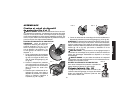
English
5
1. Place the backing flange on the machine spindle (FIG. 11 or
FIG 12).
2. Place the wheel against the flange, centering the grinding wheel
on the backing flange pilot.
3. Screw the threaded flange onto the spindle, piloting the wheel
on the backing flange hub (FIG. 13).
4. Rotate the spindle by hand while pressing the spindle lock but-
ton until the spindle locks, preventing the spindle from rotating
(Fig. 14).
5. While depressing spindle lock button, firmly tighten the thread-
ed flange with supplied hex wrench (Fig. 15).
FIG. 11
FIG. 13
FIG. 14
FIG. 15
with either matching flanges or with depressed center flanges if
they are under 5" in diameter. 6" depressed center edge-grinding
wheels (for DW827 only) must be mounted with depressed center
flanges only. Refer to the chart below to select the appropriate
flange and guard for your wheel.
CAUTION: Wheels used for cutting and edge grinding may break
if they bend or twist while the tool is being used to do cut-off work or
deep grinding. To reduce the risk of serious injury, limit the use of
these wheels with a standard type 27 guard to shallow cutting and
notching (less than 1/2" in depth). The open side of the guard must
be positioned away from the operator. For deeper cutting with a type
1 wheel, use a closed, type 1 guard (FIG. 2). Type 1 guards are avail-
able at extra cost from your local dealer or authorized service center.
FIG. 12
Application
Shape
Wheel
Type
Flange
Guard
Type
shallow
cutting
depressed
center, 5"
or smaller
type
27
matching flanges
or depressed
center flanges
type
27
shallow
cutting
depressed
center, 6"
type
27
depressed center
flanges
type
27
all cutting
flat, 6" or
smaller
type
1
matching flanges
type 1
only
grinding
depressed
center, 5"
or smaller
type
27
matching flanges
or depressed
center flanges
type
27
grinding
depressed
center, 6"
type
27
depressed center
flanges
type
27


















